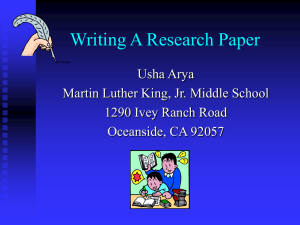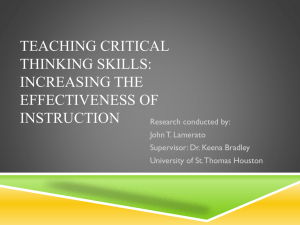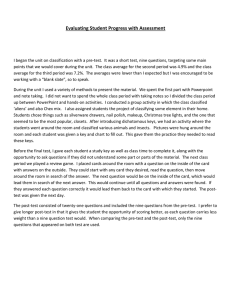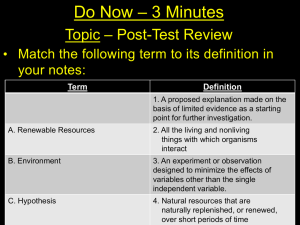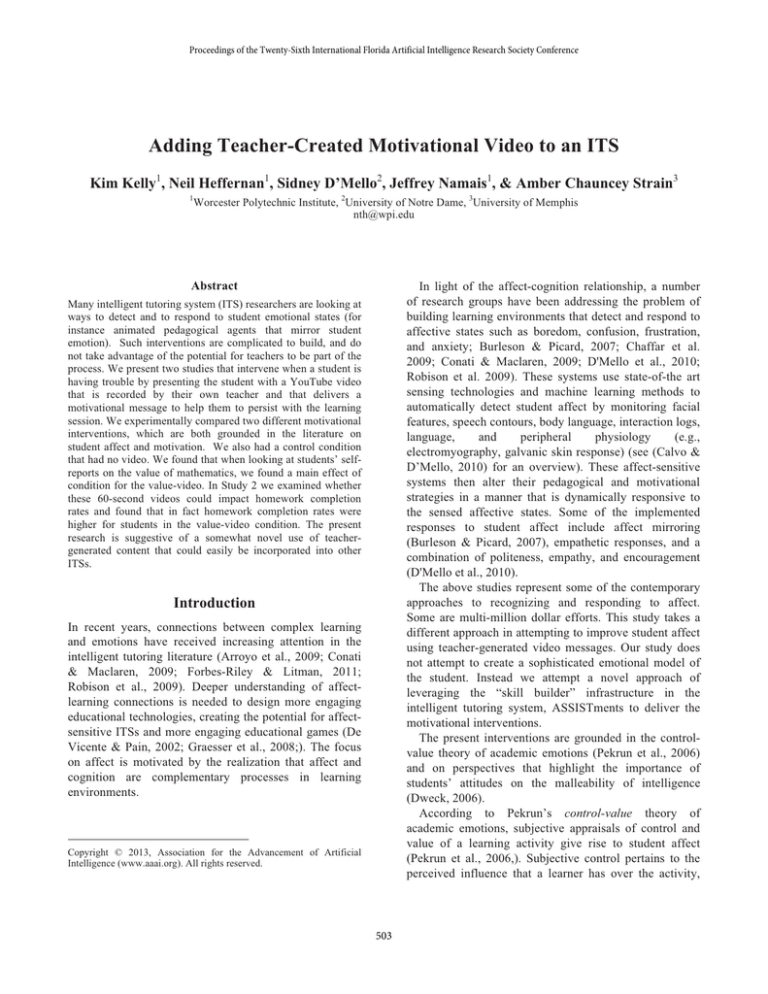
Proceedings of the Twenty-Sixth International Florida Artificial Intelligence Research Society Conference
Adding Teacher-Created Motivational Video to an ITS
Kim Kelly1, Neil Heffernan1, Sidney D’Mello2, Jeffrey Namais1, & Amber Chauncey Strain3
1
Worcester Polytechnic Institute, 2University of Notre Dame, 3University of Memphis
nth@wpi.edu
In light of the affect-cognition relationship, a number
of research groups have been addressing the problem of
building learning environments that detect and respond to
affective states such as boredom, confusion, frustration,
and anxiety; Burleson & Picard, 2007; Chaffar et al.
2009; Conati & Maclaren, 2009; D'Mello et al., 2010;
Robison et al. 2009). These systems use state-of-the art
sensing technologies and machine learning methods to
automatically detect student affect by monitoring facial
features, speech contours, body language, interaction logs,
language,
and
peripheral
physiology
(e.g.,
electromyography, galvanic skin response) (see (Calvo &
D’Mello, 2010) for an overview). These affect-sensitive
systems then alter their pedagogical and motivational
strategies in a manner that is dynamically responsive to
the sensed affective states. Some of the implemented
responses to student affect include affect mirroring
(Burleson & Picard, 2007), empathetic responses, and a
combination of politeness, empathy, and encouragement
(D'Mello et al., 2010).
The above studies represent some of the contemporary
approaches to recognizing and responding to affect.
Some are multi-million dollar efforts. This study takes a
different approach in attempting to improve student affect
using teacher-generated video messages. Our study does
not attempt to create a sophisticated emotional model of
the student. Instead we attempt a novel approach of
leveraging the “skill builder” infrastructure in the
intelligent tutoring system, ASSISTments to deliver the
motivational interventions.
The present interventions are grounded in the controlvalue theory of academic emotions (Pekrun et al., 2006)
and on perspectives that highlight the importance of
students’ attitudes on the malleability of intelligence
(Dweck, 2006).
According to Pekrun’s control-value theory of
academic emotions, subjective appraisals of control and
value of a learning activity give rise to student affect
(Pekrun et al., 2006,). Subjective control pertains to the
perceived influence that a learner has over the activity,
Abstract
Many intelligent tutoring system (ITS) researchers are looking at
ways to detect and to respond to student emotional states (for
instance animated pedagogical agents that mirror student
emotion). Such interventions are complicated to build, and do
not take advantage of the potential for teachers to be part of the
process. We present two studies that intervene when a student is
having trouble by presenting the student with a YouTube video
that is recorded by their own teacher and that delivers a
motivational message to help them to persist with the learning
session. We experimentally compared two different motivational
interventions, which are both grounded in the literature on
student affect and motivation. We also had a control condition
that had no video. We found that when looking at students’ selfreports on the value of mathematics, we found a main effect of
condition for the value-video. In Study 2 we examined whether
these 60-second videos could impact homework completion
rates and found that in fact homework completion rates were
higher for students in the value-video condition. The present
research is suggestive of a somewhat novel use of teachergenerated content that could easily be incorporated into other
ITSs.
Introduction
In recent years, connections between complex learning
and emotions have received increasing attention in the
intelligent tutoring literature (Arroyo et al., 2009; Conati
& Maclaren, 2009; Forbes-Riley & Litman, 2011;
Robison et al., 2009). Deeper understanding of affectlearning connections is needed to design more engaging
educational technologies, creating the potential for affectsensitive ITSs and more engaging educational games (De
Vicente & Pain, 2002; Graesser et al., 2008;). The focus
on affect is motivated by the realization that affect and
cognition are complementary processes in learning
environments.
Copyright © 2013, Association for the Advancement of Artificial
Intelligence (www.aaai.org). All rights reserved.
503
learning gains. Measures of perseverance include
homework completion (Fredricks et al., 2011).
Much of the prior work that attempted to manipulate
the fixed mindset was done in a laboratory setting. These
interventions are unique in that they were tested in the
context of a real math class and over the course of an
actual homework assignment with ASSISTments, a math
ITS (Mendicino et al., 2009; Kelly et al, submitted), thus
providing ecological validity. ASSISTments allows
students to complete problem sets for homework,
providing tutoring and hints at the student’s request. The
pre and post-tests were administered during class before
and after the targeted homework assignment with
ASSISTments, respectively. These students were
accustomed to using ASSISTments, so, while the
embedded video was novel, the homework task was not.
The research questions are:
1a. Can a teacher-generated video help change students’
perceptions of the value of math or encourage a “growth
mind-set”? (Study 1 and 2)
1b. Can the motivational videos increase persistence, as
measured by homework completion? (Study 2)
2a. Does one video (control or value) have a greater
impact on student perceptions than the other? (Study 1 &
2).
2b. Does one video (control or value) have a greater
impact on homework completion rates than the other?
(Study 2)
while subjective value represents the perceived value of
the outcomes of the activity. Engagement is increased
when task value is high, but boredom dominates when
learners feel like they are being forced to exert effort on
an activity they do not value (Pekrun et al., 2010).
Therefore, one would expect that students completing a
homework assignment might experience boredom when
task value is perceived as being low or when problem
difficulty is considerably below or above their skill level.
In a related vein, Dweck and colleagues discovered that
people with trait-based beliefs in their own competencies
(also termed the “entity theory of intelligence” or the
“fixed mindset”) are much more likely to disengage when
they are confronted with challenges and threats of failure
(Dweck, 2006). In contrast, individuals who believe that
their competency can be developed with practice and
effort (i.e., the “incremental theory of intelligence” or the
“growth mindset”) are more resilient to failure and its
resultant negative effect (such as frustration or anxiety).
Past research suggests that messages that help students
change their attributions of failure from external, fixed,
and uncontrollable factors to internal, malleable, and
controllable factors are effective at re-engaging students
(Shores & Smith, 2010;). Students are expected to
become frustrated and disengage when they perceive that
the learning task is out of their control due to adherence to
entity theories of intelligence.
In line with these theories, one proposed intervention
consists of displaying a video message designed to help
learners appraise the learning task, so as to increase its
perceived value (value-video condition). The message
reminds learners that although they may see little value in
the specific current task (e.g., surface area of 3dimensional figures), each task helps to broaden and build
upon their math skills, get a good grade, progress to the
next grade level, and that the content covered has the
potential to be used in a future career or to improve
general problem solving abilities. The other intervention
(control-video) incorporates a motivational video message
to the students in order to help them alter their attributions
of failure, and promote a growth mindset. This
intervention emphasizes the fact that failure is part of
learning and if the student continues to work hard, they
will be met with success. A third condition, called the no
video condition serves as the experimental control.
Such interventions are intended to address student
beliefs; targeting attributes like “grit” rather than provide
academic assistance. Therefore, immediate learning gains
are not to be expected. However, it has been determined
that “grit”, or perseverance, is essential to success in a
variety of domains (Duckworth et al., 2007). This
suggests that interventions that positively impact grit and
increase persistence, might lead to higher long-term
Study 1
This study attempted to use an intelligent tutoring system
to deliver a motivational message in the form of a video
starring the teacher. The videos targeted either students’
value in or their control over the learning activity. The
effects of the videos on students’ perceived value, control,
and learning gains were measured and analyzed.
Videos
The intervention consisted of students viewing one of two
possible videos. The teacher used a video camera to
record herself reading the script. The videos were then
uploaded to YouTube and the link to the video was an i
frame embedded into the html of the problem in
ASSISTments. The videos were of their math teacher
delivering a motivational intervention. The control video
had the teacher explaining that if the student works hard,
they can be successful. The value video had the teacher
explaining how important math homework is to learning
as well as to their future. (See Kelly (2012b) for the actual
videos). The script for the control video was based on
Dweck’s (2006) work on mindset. However, the first
author, who was the teacher in the study, revised the
504
scripts multiple times to tailor them to middle school
students. For example, to convince students that their
work in math class has value, a reference to problem
solving in video games was made as an appropriate
connection. A primary goal was to keep the videos short
in order to ensure that students were engaged.
Results
Five students answered the first three questions on the
homework assignment correctly. They did not receive the
intervention and were therefore excluded from the
analysis. Only students who completed all of the tasks
were included (n=16). There were no significant
differences found on the pre-test or conceptions survey
prior to the intervention.
The results of the survey questions are shown in Table
1. An ANOVA showed a significant main effect of value
video (F(2,13)=4.51, p=0.03) after completing the
homework assignment. Specifically, post hoc tests
showed that students viewing the value video showed
marginally higher appraisals of the perceived value of
math than the students in the no video condition
immediately
after
the
homework
assignment
(F(1,14)=3.01, p=0.084). The effect size, using Hedges
correction (CEM 2013), was estimated to be 1.22.. This
effect was stronger the following day on the immediate
post-test (F(1,14)=4.30, p=0.037), with an effect size of
1.52 and a 95% confidence interval of 0.22 to 2.82. This
effect lasted to a lesser degree (effect size of 0.92),
several days later on the delayed post-test (F(1,14)=2.09,
p=0.12)..
There were no significant differences of meaningful
trends for the control-video, which suggests that this
intervention was less successful than the value video. We
were also unable to measure perseverance through
homework completion rates since all students completed
the assignment.
Participants and Design
Twenty-four 7th grade students in a suburban school in
Massachusetts participated in this study as part of their
homework in their math class. In an attempt to balance
the groups, students were blocked into groups based on
prior knowledge. This was done using students’ current
averages in math class, ordering them from least to
greatest, taking three consecutive students at a time and
randomly assigning them to the no-video condition (n=8),
control video condition (n=8), or value video condition
(n=8).
Procedure
Students were given a pre-test and a pre-conception
survey in class. The pre-test consisted of five content
questions (adding and subtracting fractions). The actual
pre-test can be found in Kelly (2012a). The preconceptions survey consisted of five questions to measure
attitudes towards value and control. The survey questions
were adapted from the Academic Emotions Questionnaire
(Pekrun, Goetz & Perry 2005) and responses were
measured via a 5-point Likert scale. See Kelly (2012) for
the questions and other study materials.
Students were then given a homework assignment in
ASSISTments. As part of the students’ typical routine,
this assignment was completed at home as their math
homework. The homework started with three content
related questions that were morphologically similar to the
pre-test. Students in the experimental conditions, who got
at least one of these questions wrong were given a link to
either the control video or the value video. The
assignment continued with content related questions until
the student independently and correctly answered three
consecutive questions. Correctness feedback was
provided and hints were available upon student request to
assist in answering questions. Finally, after completing
the content questions, students were given the same five
survey questions that had been asked during the pre-test.
To see the entire assignment, as a student would
experience it, see Kelly (2012c).
The next day, students were given a post-test in class.
The post-test consisted of five morphologically similar,
content related questions. Five days later, a retention
post-test was given consisting of five content related
questions (see Kelly (2012d) for the items). Students also
completed the 5-item survey at both these testing points.
Table 1: Mean and standard deviations (in parenthesis) for
survey questions asked during each task by condition.
Pre Test
Homework
Immediate Post
Delayed Post
No Video
Value Video
Control Video
No Video
Value Video
Control Video
No Video
Value Video
Control Video
No Video
Value Video
Control Video
Value
Control
3.6 (0.6)
3.8 (0.8)
4.3 (0.3)
3.6 (0.6)
4.4 (0.7)
4.1 (0.5)
3.3 (0.6)
4.3 (0.7)
3.5 (0.6)
3.4 (0.5)
4.1 (1.0)
3.1 (0.9)
4.2 (0.4)
4.4 (0.4)
4.4 (0.5)
4.3 (0.4)
4.4 (0.2)
4.4 (0.5)
4.1 (0.5)
4.2 (0.5)
4.0 (1.1)
4.2 (0.5)
3.8 (1.1)
3.8 (0.9)
Additionally, due to the small sample size and scale of
the intervention, differences in learning gains were not
expected. However, for completeness, mean scores were
calculated and can be found in Kelly (2012). As expected,
learning gains were not reliably different on the
505
immediate post-test (F(2,13)=0.036, p=0.9), or the
delayed post-test (F(2,13)=0.067, p=0.9).
The following day, in-class, students were given a posttest. This test consisted of six questions that were
morphologically similar to the ones given on the pre-test.
Finally, six days later students were given a retention
post-test, again consisting of six morphologically similar
questions. Following the retention post-test, students were
given the same eight survey questions. To preview an
actual post-test see Kelly (2012f).
Study 2
Based on the results of Study 1, we refined the procedure
before replicating the study. The homework task was
lengthened and made more challenging so that differences
in homework completion rates could be calculated, the
pre-test was embedded in the homework, and the
preconception survey was administered twice instead of
four times.
Results
Sixteen students who answered the first six questions
correctly did not receive the intervention and were
therefore not included in the analyses. To analyze
homework completion rates, only those students who
attempted the homework assignment were included in the
analysis (n=60). Students in the value video condition had
substantially higher homework completion rates (95%)
when compared to students in the control video (70%)
and no video conditions (69%). A Chi-Square test
revealed that these differences were marginally significant
(X2(2)=4.611, p=0.099).
For the analysis regarding survey questions and
learning gains, only students who completed all three
tasks, and who received the intervention (in the case of
the experimental condition) were included in the analysis
(n=27). Responses to the value and control questions were
averaged together, with question 7 being reversed scored.
There was no condition effect for the control video or
value video, thereby failing to replicate a finding from
Study 1. It is important to note, that students had to
complete the homework to receive the survey questions.
Therefore, there is the potential for selection bias in these
results; specifically, if students that got the value video
were more likely to complete their homework, the sample
of students in the value condition might have a different
perception of the survey questions. This possible source
of bias might account for our failure to replicate the
findings from Study 1 pertaining to the value-video.
Similar to Study 1, no significant differences were
found in percent correct on the immediate post-test
(F(2,25)=1.67, p=0.20) or the delayed post-test
(F(2,25)=1.27, p=0.30). See Table 2 for average
perceptions and test scores by condition.
Participants and Design
Seventy-six 8th grade students in a suburban school in
Massachusetts participated in this study as part of their
homework in their algebra math class. As in Study 1,
groups were balanced using blocking on prior knowledge,
and were then randomly assigned to a no-video condition
(n=29), control video condition (n=38), or value video
condition (n=38).
Procedure
Students were given a homework assignment in
ASSISTments. The first six questions of the assignment
were used as a pre-test to assess how fluent students were
in finding the surface area of cylinders. Students who
answered all six questions correctly (n= 16) were then
given survey questions but were not given the
intervention and were therefore not included in the study.
Following the pre-test, students in the experimental
condition, who answered at least one question incorrectly,
were given a link to one of two possible videos on
YouTube. The videos were the same from Study 1.
Students were then asked to indicate how many questions
they though they answered correctly. Students in the novideo condition were simply asked this question and were
not given a link to a video.
Students then began the homework assignment, which
consisted of three sections. The first section required
students to find the surface area of a cylinder. Students
completed this section by answering three questions in a
row correctly. The second section required students to,
given the surface area, find the height, radius, diameter,
base area, or lateral surface area. Again, students
completed this section by answering three questions in a
row correctly.
ASSISTments provided correctness
feedback as well as offered hints on demand to students.
The third section of the assignment consisted of eight
survey questions to measure students’ attitudes towards
value and control. A 5-point Likert scale was used. Based
on student feedback from Study 1, we limited the number
of times we asked students these questions and therefore
included additional questions for a more robust measure
(see Kelly 2012e).
Table 2. Means and standard deviations (in parenthesis) of survey
questions on each task by condition and for percent of correct answers
on knowledge tests
Survey Questions
HW Control
HW Value
Post-Test Control
Post-Test Value
Test Performance
Pretest
Immediate Post
Delayed Post
506
Control
Value
No Video
4.0 (0.5)
3.7 (1.1)
3.6 (0.8)
3.9 (0.9)
3.6 (0.3)
4.1 (0.6)
3.4 (0.5)
3.9 (0.8)
4.1 (0.5)
4.4 (0.8)
3.8 (0.3)
4.1 (0.7)
65% (22)
87% (12)
95% (5)
64% (21)
77% (23)
89% (13)
56% (33)
92% (9)
95% (4)
engagement, and other problematic behaviors (Sao Pedro
et al. (submitted). More research is needed to see if
personalizing motivational feedback to individual
students goals and needs is an effective way of improving
ITSs.
It is also important to compare the effectiveness of
teacher-generated messages versus other motivational
messages. It could be that teacher created video are more
effective due to the fact they come for the students teacher
rather than some generic source
(maybe a paid
professional actor) or an animated pedagogical agent.
An added benefit might be an increase in teachers’
willingness to adopt the ITS if they feel they can override
system default messages with their own personalized
messages.
In conclusion, Study 1 showed promising results in the
ability to alter student perceptions of the value of math by
showing a short, teacher-generated video during a
homework assignment. Study 2 showed that this
intervention might also increase motivation and therefore
homework completion rates, which over time could lead
to improved learning. These studies were intended to
serve as a proof-of-concept to test the idea that there
might be potential benefits for including teacher-delivered
motivational interventions within the context of
mathematics homework completion with an ITS. Further
research is needed to refine the interventions, augment the
infrastructure to afford easy production of additional
messages for a variety of situations by a variety of
teachers, understand how to tailor messages to different
situations and learners, and to study the long-term
efficacy of this approach to facilitate learning by
increasing motivation to persist in light of difficulty when
it is so much easier to simply give up.
Contributions and Discussion
This study suggests a novel use of ITS in a highly
ecologically valid situation (i.e., use in a real math
classroom for homework).
We hypothesized that
providing motivational videos from students’ own teacher
might increase their motivation and problem completion
rates. We found a positive effect for the value-focused
video on students’ perceptions of value in math in Study 1
and on homework completion rates in Study 2. The
control-video did not yield any benefits over not receiving
a video.
We anticipated the difficulty in obtaining statistically
significant effects given that our intervention consisted of
a 60-second video and the sample sizes were quite small.
Clearly, future studies should be conducted implementing
more substantial and long-term interventions. A longerterm study might also address the significant attrition we
encountered, as there would be more opportunities for
intervention and growth.
We acknowledge that the empirical contributions of
this work are modest. Instead, the main contribution of
this paper is to develop a proof-of-concept of costeffective motivational interventions in ITSs. The longterm goal of this research is to identify interventions that
work (from both a cognitive and motivational standpoint)
and to deploy these at the appropriate time. For example,
we envision a system that identifies when and why
students are struggling and displays different types of
prerecorded messages. There will need to be different
messages for different anticipated problems; some might
be content related but others might be focused on
motivation. We are in the process of augmenting
ASSISTments with the infrastructure to support teachers
posting their own messages for common situations, and
these messages can be accompanied with videos, which
would allow us to test the hypothesis that individual
teacher messages might be better than generic messages.
Additionally, matching the interventions to the specific
needs of the student might yield more impressive
outcomes. Specifically, a learner who is struggling and
therefore risks disengagement due to low appraisal of
control (despite valuing mathematics) might receive
supportive messages or a video to help the student have a
greater sense of control. This intervention might succeed
in alleviating boredom in the short-term, but boredom
might emerge as the session progresses (value decreases)
and as the topic is mastered (control increases). In this
situation, additional messages, either text or video, may
be required. Similarly, offering praise for success should
also be investigated.
Simple user modeling techniques might allow for more
personalized messages, however more sophisticated
tracking of student affect might be needed for finer
grained interventions. For example, ASSISTments is
currently incorporating automated detectors of boredom,
Acknowledgements
Bill and Melinda Foundation via EDUCAUSE, IES grants
R305C100024 and R305A120125, and NSF grants ITR
0325428, HCC 0834847, DRL 1235958.
References
Arroyo, I., Woolf, B., Cooper, D., Burleson, W., Muldner, K., &
Christopherson, R. (2009). Emotion sensors go to school. In V.
Dimitrova, R. Mizoguchi, B. Du Boulay & A. Graesser (Eds.),
Proceedings of 14th International Conference on Artificial
Intelligence In Education (pp. 17-24). Amsterdam: IOS Press.
Burleson, W. & Picard, R. W. (2007) Affective Learning
Companions. Special Issue on Pedagogical Agents, Educational
Technology, Saddle Brook, N.J., Vol. 47, no. 1, pp. 28-32, ISSN
0013-1962.
Calvo, R., D'Mello, S. (2010). Affect Detection: An
Interdisciplinary Review of Models, Methods, and Their
507
Applications, IEEE Transactions on Affective Computing, v.1
n.1, p.18-37
Kelly, K. (2012a-f). sites.google.com/site/flairsdata/ (study
materials, data, and tables)
Study 1 Materials. Accessed 11/1/12.
a. Pre-Test: http://www.webcitation.org/6CCmWVad5
b. Control Video: http://www.webcitation.org/6CCmq7KpZ &
Value Video: http://www.webcitation.org/6CCmiK5pb
c. Homework Assignment: http://tinyurl.com/cbze4nr
d. Post-Test: http://www.webcitation.org/6CCoZrovS
Study 2 Materials. Accessed 11/15/12
e. Homework Assignment: http://tinyurl.com/c6k64ys
f. Post-Test: http://www.webcitation.org/6CCoqgspN
CEM (2013). Accessed 1/28/13 at
http://www.cemcentre.org/evidence-based-education/effect-sizecalculator.
Chaffar, S,, Derbali, L., Frasson, C. (2009). Inducing positive
emotional state in Intelligent Tutoring Systems, Proceedings of
the 2009 conference on Artificial Intelligence in Education:
Building Learning Systems that Care: From Knowledge
Representation to Affective Modeling, p.716-718, July 20, 2009
Conati, C., & Maclaren, H. (2009). Empirically building and
evaluating a probabilistic model of user affect. User Modeling
and User-Adapted Interaction, 19(3), 267-303.
Kelly, K., Heffernan, N., Heffernan, C., Goldman, S.,
Pellegrino, J., & Soffer Goldstein, D. (Submitted). Estimating
the effect of web-based homework. The Artificial Intelligence in
Education Conference. Memphis 2013.
D'Mello, S., Lehman, B., Sullins, J, Daigle, R., Combs, R.,
Vogt, K., Perkins, L., Graesser, A. (2010). A time for emoting:
when affect-sensitivity is and isn't effective at promoting deep
learning, Proceedings of the 10th international conference on
Intelligent Tutoring Systems, June 14-18, 2010, Pittsburgh, PA
Mendicino, M., Razzaq, L. & Heffernan, N. T. (2009).
Comparison of Traditional Homework with Computer
Supported Homework. Journal of Research on Technology in
Education, 41(3), 331-359.
Pekrun, R., Goetz, T., & Perry, R. P. (2005). Academic
Emotions Questionnaire (AEQ). User’s Manuel. Department of
Psychology, University of Munich.
De Vicente, A., & Pain, H. (2002). Informing the detection of
the students' motivational state: An empirical study. In S. A.
Cerri, G. Gouarderes & F. Paraguacu (Eds.), 6th International
Conference on Intelligent Tutoring Systems (pp. 933-943). San
Sebastian, Spain.
Pekrun, R. (2006). The control-value theory of achievement
emotions: Assumptions, corollaries, and implications for
educational research and practice. Educational Psychology
Review, 18(4), 315-341.
Duckworth, A. L., Peterson, C., Matthews, M. D., & Kelly, D.
R. (2007). Grit: perseverance and passion for long-term goals.
Journal of Personality and Social Psychology; Journal of
Personality and Social Psychology, 92(6), 1087.
Robison, J., McQuiggan, S., & Lester, J. (2009). Evaluating the
consequences of affective feedback in intelligent tutoring
systems. Paper presented at the International Conference on
Affective Computing & Intelligent Interaction, Amsterdam.
Dweck, C. (2006). Mindset. New York: Random House.
Forbes-Riley, K., & Litman, D. J. (2011). Benefits and
challenges of real-time uncertainty detection and adaptation in a
spoken dialogue computer tutor. Speech Communication, 53(910), 1115-1136. doi: 10.1016/j.specom.2011.02.006
Shores, M. L., & Smith, T. (2010). Attribution in Mathematics:
A Review of Literature. School Science and Mathematics,
110(1), 24-30.
Sao Pedro, M., Baker, R., Gowda, S., & Heffernan, N.
(submitted). Towards an Understanding of Affect and
Knowledge from Student Interaction with an Intelligent
Tutoring System. The Artificial Intelligence in Education
Conference. Memphis. 2013.
Fredricks, J., McColskey, W., Meli, J., Mordica, J., Montrosse,
B., and Mooney, K. (2011). Measuring student engagement in
upper elementary through high school: a description of 21
instruments. (Issues & Answers Report, REL 2011–No. 098).
Washington, DC: U.S. Department of Education, Institute of
Education Sciences, National Center for Education Evaluation
and Regional Assistance, Regional Educational Laboratory
Southeast. Retrieved from http://ies.ed.gov/ncee/edlabs.
Graesser, A., Jeon, M., & Dufty, D. (2008). Agent technologies
designed to facilitate interactive knowledge construction.
Discourse Processes, 45 (4-5), 298-322.
508



